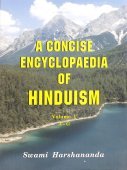Narasimhapurana, Narasiṃhapurāṇa, Narasimha-purana: 5 definitions
Introduction:
Narasimhapurana means something in Hinduism, Sanskrit. If you want to know the exact meaning, history, etymology or English translation of this term then check out the descriptions on this page. Add your comment or reference to a book if you want to contribute to this summary article.
In Hinduism
Purana and Itihasa (epic history)
Source: Shodhganga: Elements of Art and Architecture in the Trtiyakhanda of the VisnudharmottarapuranaNarasiṃhapurāṇa (नरसिंहपुराण) refers to one of the eighteen Major Puranas according to the Brahmāṇḍapurāṇa and other traditional lists of Puranic literature: a category of ancient Sanskrit texts which gives a huge contribution in the development of Indian literature.—The lists of eighteen Mahāpurāṇas (e.g., narasiṃhapurāṇa) and eighteen Upapurāṇas are not same everywhere, as some names are dropped in some references whereas some are included in others. It can be noticed that, except the Vāyuapurāṇa and the Śivapurāṇa, the names of the Mahāpurāṇas are similar in almost all the Purāṇas.

The Purana (पुराण, purāṇas) refers to Sanskrit literature preserving ancient India’s vast cultural history, including historical legends, religious ceremonies, various arts and sciences. The eighteen mahapuranas total over 400,000 shlokas (metrical couplets) and date to at least several centuries BCE.
Languages of India and abroad
Sanskrit dictionary
Source: Cologne Digital Sanskrit Dictionaries: Aufrecht Catalogus Catalogorum1) Narasiṃhapurāṇa (नरसिंहपुराण) as mentioned in Aufrecht’s Catalogus Catalogorum:—See Nṛsiṃhapurāṇa.
2) Narasiṃhapurāṇa (नरसिंहपुराण):—Io. 1800. 2054. Oxf. 82^a
—84^a. Paris. (B 11). L. 1020. Khn. 26. K. 24. B. 2, 12. Ben. 56. 57. Bik. 207. Tu7b. 13. Kāṭm. 2. Rādh. 39. Np. Viii, 20. Burnell. 188^a. P. 9. Poona. 428. Oppert. 6011. Ii, 943. 3183. 4035. Rice. 72. Bp. 292. Mentioned in Kūrmapurāṇa Oxf. 8^a, Matsyapurāṇa Oxf. 40^b, Śivapurāṇa Oxf. 65^b, Gaṇeśapurāṇa Oxf. 78^a, Devībhāgavatapurāṇa Oxf. 80^a. Nṛsiṃhapurāṇe Nṛsiṃhakalpa. L. 1308.
—Agnisaṃhitāyāṃ Nṛsiṃhabījastotra. Burnell. 200^b.
—Nṛsiṃhastavarāja. Burnell. 200^b.
—Lakṣmīnṛsiṃhasahasranāman. Oudh. Xiii, 100.
—Śālagrāmastotra. Burnell. 201^a.
—Sārasaṃgraha. Oudh. Xiii, 40.
Narasiṃhapurāṇa has the following synonyms: Nṛsiṃhapurāṇa.
3) Narasiṃhapurāṇa (नरसिंहपुराण):—Bl. 28. Gov. Or. Libr. Madras 44. Rgb. 158. Stein 202. Nṛsiṃhapurāṇe Lakṣmīnṛsiṃhasahasranāman. Oudh. Xxi, 156. Stein 202.
Narasiṃhapurāṇa has the following synonyms: Nṛsiṃhapurāṇa.
Source: Cologne Digital Sanskrit Dictionaries: Monier-Williams Sanskrit-English Dictionary1) Narasiṃhapurāṇa (नरसिंहपुराण):—[=nara-siṃha-purāṇa] [from nara-siṃha > nara] n. Name of [work]
2) Nārasiṃhapurāṇa (नारसिंहपुराण):—[=nārasiṃha-purāṇa] [from nārasiṃha] n. Name of a, [Purāṇa]
[Sanskrit to German]
Sanskrit, also spelled संस्कृतम् (saṃskṛtam), is an ancient language of India commonly seen as the grandmother of the Indo-European language family (even English!). Closely allied with Prakrit and Pali, Sanskrit is more exhaustive in both grammar and terms and has the most extensive collection of literature in the world, greatly surpassing its sister-languages Greek and Latin.
Kannada-English dictionary
Source: Alar: Kannada-English corpusNārasiṃhapurāṇa (ನಾರಸಿಂಹಪುರಾಣ):—[noun] one of the eighteen Hindu Purāṇas which deals with the legend of the fourth incarnation of Viṣṇu, in the form of half-lion and half-man.
Kannada is a Dravidian language (as opposed to the Indo-European language family) mainly spoken in the southwestern region of India.
See also (Relevant definitions)
Partial matches: Purana, Puraana, Narasimha.
Ends with: Brihannarasimhapurana.
Full-text: Ghotkara, Arbudaranya, Kaumaraparvata, Sauranakta, Upapurana, Narasimha, Matsyapradurbhava, Tiryaksrotas, Nrisimhapurana, Citrasena, Trinabindu, Kurma, Tryambaka, Kurca.
Relevant text
Search found 8 books and stories containing Narasimhapurana, Narasiṃhapurāṇa, Narasimha-purana, Narasiṃha-purāṇa, Nārasiṃhapurāṇa, Nārasiṃha-purāṇa, Nārasimhapurāṇa, Nārasimha-purāṇa; (plurals include: Narasimhapuranas, Narasiṃhapurāṇas, puranas, purāṇas, Nārasiṃhapurāṇas, Nārasimhapurāṇas). You can also click to the full overview containing English textual excerpts. Below are direct links for the most relevant articles:
Bhakti-rasamrta-sindhu (by Śrīla Rūpa Gosvāmī)
Verse 1.2.179 < [Part 2 - Devotional Service in Practice (sādhana-bhakti)]
Verse 1.2.159 < [Part 2 - Devotional Service in Practice (sādhana-bhakti)]
Verse 1.2.202 < [Part 2 - Devotional Service in Practice (sādhana-bhakti)]
Vishnudharmottara Purana (Art and Architecture) (by Bhagyashree Sarma)
1. A General Note on Purāṇas < [Chapter 1 - Introduction]
Brihad Bhagavatamrita (commentary) (by Śrī Śrīmad Bhaktivedānta Nārāyana Gosvāmī Mahārāja)
Verse 1.4.8 < [Chapter 4 - Bhakta (the devotee)]
Verse 2.2.186 < [Chapter 2 - Jñāna (knowledge)]
Rivers in Ancient India (study) (by Archana Sarma)
11. Descriptions of the rivers in the Jambudvīpa < [Chapter 5 - Rivers in the Purāṇic Literature]
The Markandeya Purana (Study) (by Chandamita Bhattacharya)
1.6: Number of Purāṇa < [Chapter 1]
Formal Education System in Ancient India (by Sushmita Nath)
Education in the Puranic period < [Chapter 1 - Introduction]
Related products
